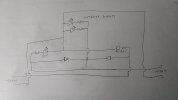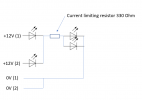DafyddElvy
1:22.5 & 15mm Scale Trams, , NG Steam Railways
Some electronics help please to check what I have sketched out.
This is an idea for some electrical wiring internal to a trams trailer, where tram is noted this is a two wire connection to the powered tram.
What I want to do is operate the trailers red tail lamp dependant on which end the tram is connected (only the rear end lit at any time) and use the same two wire connection to power the trailers internal lighting regardless as to which end the tram is connected.
The LEDs are teenie weenie with minimal power requirements.
My question is, will this simple circuit work and what rating would I need for the diodes?
Thanks to anyone who can help.
David
This is an idea for some electrical wiring internal to a trams trailer, where tram is noted this is a two wire connection to the powered tram.
What I want to do is operate the trailers red tail lamp dependant on which end the tram is connected (only the rear end lit at any time) and use the same two wire connection to power the trailers internal lighting regardless as to which end the tram is connected.
The LEDs are teenie weenie with minimal power requirements.
My question is, will this simple circuit work and what rating would I need for the diodes?
Thanks to anyone who can help.
David


